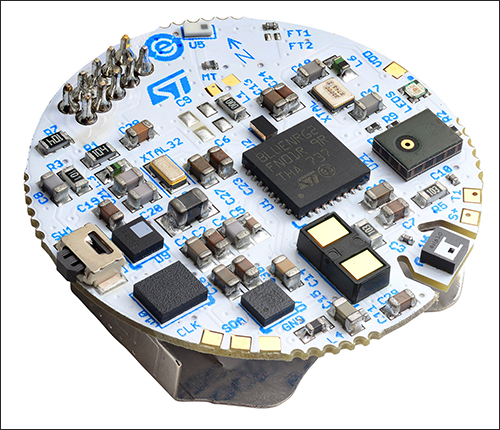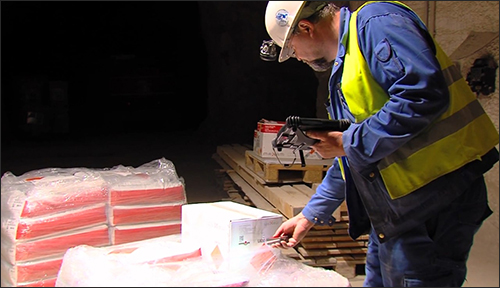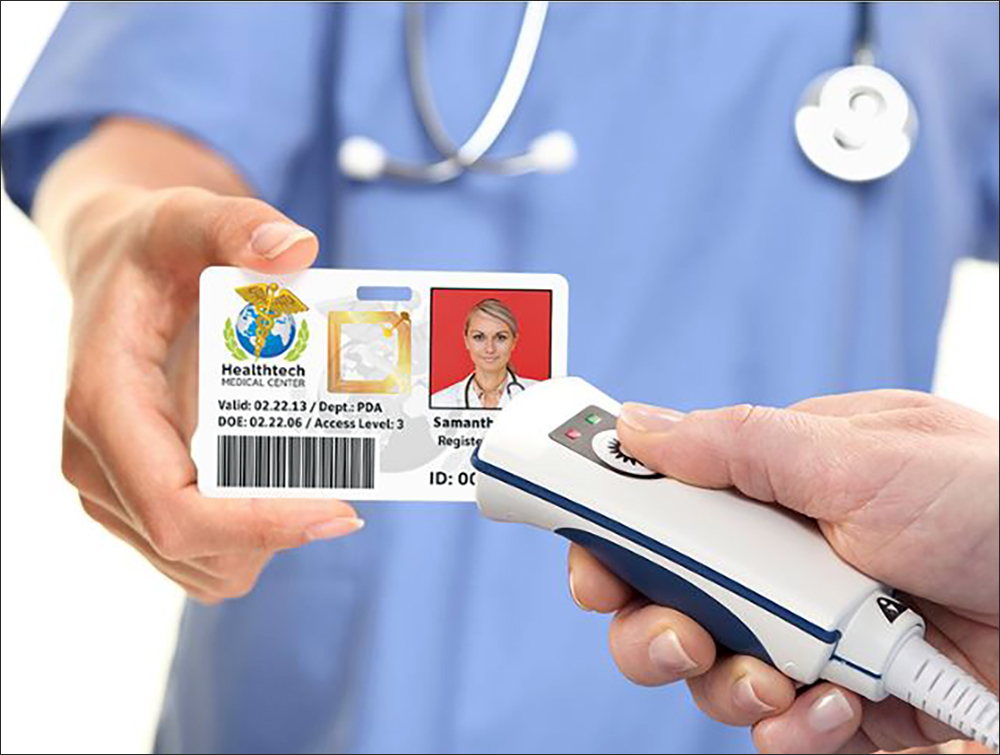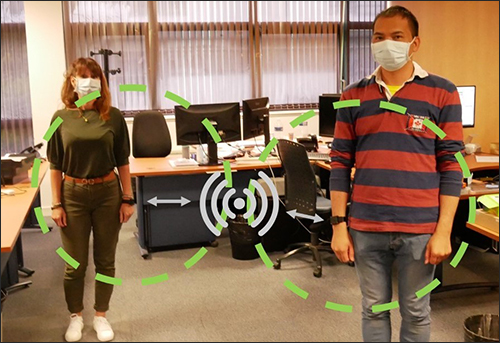Jun 11, 2020Presented here are news announcements made during the past week regarding the following organizations: STMicroelectronics, oneM2M, Bosch Sensortec, Qualcomm Technologies, Kathrein, JADAK and Insight SiP.
STMicroelectronics Reference Design Monitors Social Distancing, Contact Tracing
Semiconductor company STMicroelectronics has announced the availability of its new reference design for monitoring social distancing, as well as assuring remote operation, provisioning, warning and anti-tampering. The new design, according to the company, can potentially provide contact tracing to protect human health in a variety of environments, including in response to global or local pandemic conditions.
Leveraging Bluetooth Low Energy (BLE) technology through its incorporation of ST's ultra-low-power BlueNRG-2 system-on-chip with tunable RF output power, the BlueNRG-Tile reference design measures the signal strength of nearby Bluetooth non-connecting beacons and, in real time, calculates proximity to these sources. The circuit can be provisioned and then operate, as well as issuing warnings if another beacon intrudes on an adjustable perimeter or when tampered with, even if it is not connected to a smartphone or 5G network.

The base reference design can be supplemented with ST's S2-LP sub-GHz ultra-low-power RF transceiver to add bidirectional tag-to-cloud communication through Sigfox's 0G Global Network, allowing private and anonymous tag provisioning, as well as notifications and an advisory return-channel for emergency warnings. To assure power economy and extend battery lifetime, the components come with a micro-electro-mechanical systems (MEMS) accelerometer that power-cycles the unit when it isn't moving. Optionally, internal or external memory could provide long-term storage of nearby beacons, allowing for contact tracing.
"Developing this highly efficient and cost-effective social-distancing reference design has significant value in any environment where people need to work safely," said Benedetto Vigna, the president of STMicroelectronics' Analog, MEMS and Sensors Group, in a prepared statement. "This compact design can be used as is or be enhanced for a wide range of applications, including as bracelets and bands or as plugins or add-ons to eyeglasses, helmets, masks and shields."
Several of ST's partners have evaluated and adopted the reference design as a foundation for location-monitoring and contact-tracing platforms, the company reports. These platforms provide a range of capabilities, including proximity alerts and contact recording, using the ST reference design packaged in compact, ultra-low-power tags. The reference design, including further technical detail on its operation, is available at the company's website and via local ST sales offices.
OneM2M Adds New Partners for IoT Interoperability
International standards initiative oneM2M has announced that several worldwide organizations have joined its membership, seeking to accelerate the development of the Internet of Things (IoT) market through greater interoperability. A cybersecurity specialist, research institutes, service providers and the Universidad Politécnica de Madrid's faculty of computer science are among the latest to join the organization. The newest additions come from the United States, Asia and Europe.
"2020 is shaping up to be a year when increased levels of collaboration between global organizations, institutions and companies really accelerate mass adoption of the IoT across a range of sectors," said Enrico Scarrone, oneM2M's Steering Committee chair, in a prepared statement. "We are already working in partnership with the IoT Connectivity Alliance (ICA) and have recently set out how we will be collaborating with the Industrial Internet Consortium (IIC). The breadth of expertise and geographic spread of our new members will further add to our global knowledge base and effort as we build the levels of seamless interoperability needed to drive forward a technologically agnostic and secure platform for the IoT."
With cybersecurity becoming an increasingly important issue, U.S.-based online authentication company Valimail is among oneM2M's new members. "We are excited to join oneM2M," said Ash Wilson, Valimail's technical director, in the prepared statement. "OneM2M's service layer standardization is an enabler for the IoT ecosystem, and secure device identity is essential for keeping the ecosystem secure, especially as IoT technology becomes ever more ubiquitous in our daily lives and routines We look forward to exploring how Valimail's expertise in email authentication can contribute to the problem of device identity validation in IoT."
OneM2M's goal of creating a single common IoT language will be helped by the Universidad Politécnica de Madrid becoming a member organization, oneM2M reports. The university's Ontology Engineering Group's is focused on the standardization of ontologies, and on semantic interoperability in general, while oneM2M views semantic interoperability as one of the IoT's key enabling technologies. Such interoperability is also a concern for Russian firm JSRPC Kryptonite, another new member.
"Our aim is to increase awareness amongst market players and regulators that IoT mass market development in Russia requires interoperability based on open standards," said Dmitry Kadomtsev, the deputy head of JSRPC Kryptonite's Laboratory of Telecommunications and Special Equipment, in the prepared statement. "It assumes enabling interoperability in a multi-vendor, multi-network, multi-service environment. We believe our collaboration with oneM2M consortium will help to enable semantic interoperability across information silos. oneM2M has reached a good level of maturity and developed a set of de-facto standards that is available to be implemented on Russian market."
Among the other new oneM2M members is the Hyderabad-based International Institute of Information Technology, which sees the IoT as crucial to its smart-city research initiatives. "We are very happy to be a part of the oneM2M standards efforts and have decided to adopt oneM2M standards for India's first 'Living Lab', which will be a proving ground for Smart City innovations," added Sachin Chaudhari, an assistant professor at the institute, in the prepared statement. "oneM2M has enabled us to create the data sandbox with a standards approach in the living lab context. We can reap the benefits and create Artificial Intelligence-based solutions on top of it in a fast and efficient way. We also look forward to contributing to the standard with our expertise and learning so that the entire community can benefit."
Bosch Sensortec, Qualcomm Team Up on Software Solutions
Bosch Sensortec has announced that it has developed sensor software in collaboration with Qualcomm Technologies, through the latter's Qualcomm Platform Solutions Ecosystem program. Under the terms of the agreement, Bosch Sensortec will develop software based on MEMS sensing solutions in the Qualcomm Sensor Execution Environment to provide features for smartphones and wearable devices.
Early developments include an angle-detection algorithm for Bosch Sensortec's Inertial Measurement Units, allowing the detection of various states in foldable smartphones. Another software solution is the Bosch Sensortec Environmental Cluster (BSEC), an environmental sensing algorithm that operates the company's BME680 environmental sensor and calculates compensated outputs for ambient pressure, temperature, relative humidity and air quality.

"We are delighted to work with Qualcomm Technologies. By developing software solutions for use with Qualcomm Sensor Execution Environment, we can provide advanced features such as angle detection for smartphones," said Peter Weigand, Bosch Sensortec's VP of marketing, in a prepared statement. "We are very pleased to have Bosch Sensortec join our Platform Solutions Ecosystem program to integrate and optimize their advanced sensor algorithms on the always-on, low power island on our Snapdragon mobile platforms," added Manvinder Singh, Qualcomm's VP of product management, in the statement.
The Qualcomm Sensor Execution Environment, a software framework for sensor drivers and algorithms, is designed to run software in a low-power domain and to optimize performance. These algorithms are available to customers developing smartphones using Qualcomm Snapdragon mobile platforms. The BME680 gas sensor integrates high-linearity and high-accuracy gas, pressure, humidity and temperature sensors. It is designed to boost power consumption, long-term stability and electro-magnetic compatibility robustness, depending on the operating mode, according to the company. In order to measure air quality for personal well-being, the gas sensor within the BME680 can detect a range of gases, such as volatile organic compounds.
FEIG Electronic Unveils RFID-Barcode Reader
FEIG Electronic has introduced its mobile ECCO+ reader, which is capable of interrogating RFID tags and scanning bar codes. The unique identification of equipment and machines using RFID transponders or barcodes enables transparent documentation throughout a product's life cycle. According to the company, the reader is intended to simplify workflows and the identification of parts.
Compliance with service intervals and maintenance work on machines, equipment and components is necessary for operation and maximum service life, FEIG notes, and servicing or maintenance orders must be carried out on plants and machinery quickly and efficiently. Service efficiency, production shutdowns and dissatisfied users can cost a company money, the firm explains. Components can be clearly identified using RFID and barcode technologies, but there is often little space on machines, equipment and components. As such, small RFID transponders often provide unique identification in places that are difficult to access.

The ECCO+ reader can detect HF and UHF RFID tags, as well as barcodes, and it can read and rewrite RFID transponders. Data is transmitted via Bluetooth or WLAN to a notebook, tablet PC, smartphone or other device. Because it has been designed for use in harsh environments, FEIG reports, the device is resistant to shocks or vibrations and can be easily operated, even by a person wearing thick work gloves.
NFC-enabled smartphones are also used to capture RFID tags, FEIG notes, but such devices have some disadvantages, such as displays being impact-sensitive. Plus, detection can generally only be triggered without gloves or with special capacitive touch screens, which makes handling difficult in some areas. Small transponders attached to metal surfaces or surrounded by metal cannot be reliably detected using this technology, the company adds. The ECCO+, however, can be brought closer to a transponder or barcode when space is limited, and the reader unit is built to accurately detect RFID tags in metallic environments.
The ECCO+ is being employed in Italy, FEIG indicates, where the construction and expansion of a fiber-optic network is currently under way, with fiber-optic lines to individual buildings bundled in distribution boxes. Inside these boxes, each paired cable and port is identified via an RFID tag and is assigned to a specific building. This information is then collected in a central system, along with the corresponding documentation. In the event of a fault, fitters can identify and locate the cables to the affected building or fault area. All fitters and installation companies are equipped with ECCO+ devices. In some cases, FEIG reports, RFID data from the ECCO+ is transferred to a tablet via Bluetooth for access by the fitters, allowing for improved troubleshooting, a reduction in errors and the documentation of maintenance work
Biorefinery Optimizes Operations With Kathrein RFID System
Kathrein Solutions reports that a specialty cellulose and biorefinery company (unnamed by Kathrein) in Northern Europe is using RFID to make its factories more transparent through lean processes. The company has a production capacity of 255,000 tons of soluble cellulose, 120,000 tons of lignin and 14,000 tons of bioethanol. All products have their origin in sustainable forestry.
The bioenergy generated by the process is used internally and makes the company virtually independent of fossil energy sources, Kathrein indicates. The products are mostly sold outside Northern Europe, with the largest markets based in Asia. The firm's aim is to adapt production and loading to the short lay times of the ships, and to thereby increase the efficiency of the entire value chain. Logistical processes through the use of RFID systems, according to Kathrein, can help to achieve this goal.
The company is using an RFID system to create lean structures and streamline processes. At the final step in the production chain, RFID tags are attached to the cellulose bales and sacks. An RFID application robot from Kathrein Solutions performs this completely automatically. In addition, Kathrein's CrossTalk software automatically ensures that outgoing goods are linked to the merchandise-management system.
All transports, intermediate storage and related processes can be automatically recorded at 12 hall entrances and exits via passive UHF RFID gates from Kathrein. The reading results are then transmitted to the logistics system in real time. When a ship docks at the company-owned dock for loading, a list has already been generated from the system. Loading is then carried out via loading transponders, which are equipped with active RFID systems.
When leaving the loading hall, the sacks or stacks of cellulose are thus identified on the wagon and automatically married to it. The active RFID system automatically registers the loading of the wagon at the dock. This ensures end-to-end tracking of the products from production to loading, with CrossTalk managing both the passive UHF RFID infrastructure and the active installation of the RFID systems.
The RFID system, in combination with the CrossTalk AutoID Platform, enable permanent inventory transparency throughout all warehouses, according to the company. This transparency helps to optimize production control and raw material management so that data is transparent and immediately available. The RFID-supported loading process is intended to reduce incidents of wrong loading, while incorrect processes during the loading operation can be largely eliminated. Ships' lay times have been reduced, Kathrein indicates, and a reduction in logistics costs has resulted.
JADAK Intros Handheld Reader With RFID, Barcode Scanning
JADAK has announced its FlexTap HS-1RS Secure Access Handheld Scanner, designed for user authentication and medical device access. The company has added high-frequency (HF) badge-reading capabilities and has enabled Imprivata software on the scanner, allowing hospitals to change their clinical workflow. The HS-1RS integrates 1D and 2D barcode scanning, HF and LF RFID proximity card reading functionality, and Imprivata software for the healthcare market.
According to the company, the scanner is designed to simplify workflows and improve efficiencies by allowing clinicians to tap their ID badges for secure user authentication and access to medical devices, while capturing barcode data, such as patient wristband or medication information. It also assists in infection control, JADAK reports, since clinicians need not touch the device to input manual usernames and passwords.

The scanner is specifically designed for the healthcare industry and for the high-performance scanning of 1D and 2D barcodes, including those damaged or poorly printed. The device can read most healthcare barcodes, JADAK notes, such as GS1 Databar, and can interpret all widely used 1D or 2D code standards. The Flexpoint HS-1 Series has a number of specialized models to address different healthcare operations.
The HS-1 Presentation Barcode Scanner, the company's base model, includes all features of the Flexpoint series, but is also capable of capturing paper documents as 8-bit grayscale digital images. The HS-1M Presentation Barcode Scanner comes with mounting options for hands-free use on medical carts, IV poles, desktops and walls. And the HS-1E Handheld Barcode Scanner accommodates non-medical applications.
The HS-1R HF RFID Reading & Writing with 1D/2D Barcode Scanning model is equipped to read HF RFID tags and support numerous HF standards, while the HS-1RL, Secure Access Handheld RFID and Barcode Scanner is a healthcare-based handheld scanner combining 1D and 2D barcodes with low-frequency (LF) RFID reading. Other models include the HS-1RS, the Secure Access Handheld RFID and Barcode Scanner, the Flexpoint HS-2 Series Wireless Bluetooth Barcode Scanner, and the HS-2MRI model.
Insight SiP Electronic Device Protects Wearers During Pandemic
Insight SiP, a French designer and manufacturer of miniaturized electronic components, has launched its Security Bubble COVID-19, an electronic device that generates virtual barriers around a wearer to help him or her comply with governmental health and safety recommendations and thereby protect citizens from coronavirus contamination. Insight SiP has designed the Security Bubble COVID-19 to be worn by those in workplaces, including offices, warehouses, factories and construction sites; commercial spaces, including pubs, restaurants, shops and supermarkets; and public spaces, including public sector offices, community centers, schools, universities and museums.
The Security Bubble COVID-19 can take the form of an electronic tag. In a given space, each person equipped with a tag generates an individual invisible Security Bubble to help her or him maintain physical distancing. The device can be programmed to meet social-distancing recommendations ranging from 1 meter (3.3 feet) to 2 meters (6.6 feet) in order to avoid contagion. The Security Bubble uses low-power microwave radio pulse technology to recognize its position in relation to other Security Bubbles, with an accuracy of a few centimeters. Each device automatically interacts with its neighboring units. If the devices come too close to each other, their signals will collide and an alarm will alert the wearers.

Due to miniaturization provided by Insight SiP, the electronics can be integrated into such products as portable identification tags, bracelets, security equipment, clothing and construction hard hats. The Security Bubbles do not capture personal data and they conform to GDPR regulations. If required, they can be adapted to retrieve data and allow tracking by integrating data storage software into the tags.
The Security Bubble uses existing technologies that function in other applications. The device is comparable to the invisible perimeter safety barriers implemented at swimming pools, the company reports, as well as the invisible safety barriers that warn workers of an unauthorized entry into a machine or robot operating area. But instead of infrared light beams, as in the examples above, Security Bubble devices use radio waves. Insight SiP has developed a prototype of the Security Bubble with basic technologies and components already in production for other applications, and the company has filed a patent. Several demonstrations are available, including tags that allow users to generate and control the Security Bubbles.
"Governments in the post-COVID-19 era will recommend social-distancing rules in workplaces and public spaces," said Michel Beghin, Insight SiP's CEO, in the prepared statement. "Our small wearable device, the Security Bubble, allows companies, public sector organizations and individuals to ensure that they comply with safety recommendations. Today, at Insight SiP, we offer our expertise and technologies to any PPE manufacturer who wants to bring such devices to market."

